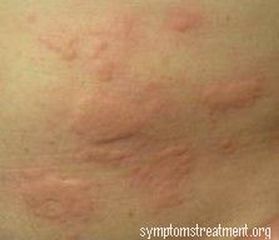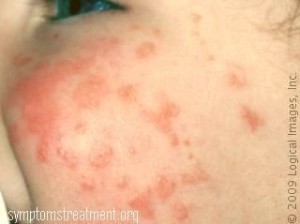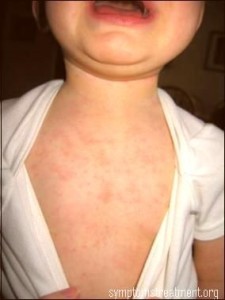What is Roseola Rash?
Roseola rash can be described as a physical health abnormality of mild nature which is caused by viral infection. Roseola starts with sudden onset and persists for a shorter duration. This condition is commonly prevalent in children and is most frequently found in children ageing 6 to 24 months. The average age at which this condition often affects people is believed to be 9 months. It is not often that older children, teenagers or even adults may get afflicted with the condition.
Is Roseola rash contagious?
Roseola is caused by certain kind of virus. The primary cause of this condition is said to be HHV- 6 virus or Human Herpes Virus 6. It is also sometimes result of HH7 or Human Herpes Virus 7. The condition may be contagious to certain extent, which can spread from person to person, especially through oral secretion; however, it is not extremely contagious. It takes around 9 to 10 days, to show simooms, from the time of the exposure to the virus which is the brooding period. Only natural host for Human Herpes Virus 6 and Human Herpes Virus 7 are humans. The condition may affect anyone irrespective of age, sex, region or season, unlike other infection caused by virus.
Symptoms of Roseola rash
Roseola rash can itself be a symptom of underlying disease or disorder. To your information, symptoms of HHV 6 and HHV 7 may differ according to ages of the affected individual. In case of infants and toddlers common symptoms may include high fever which may also persist for three to five days. There are other symptoms that may accompany the condition such as irritability, fontanel (bulging of head), engorged glands on neck region, rhinitis, swelling of eyelids due to fluid and diarrhea. Within approximately 12 to 24 hours from the onset of the fever rashes may start developing. Older children who get afflicted with Human Herpes Virus 6 and 7 may suffer from illness which may persist for several days. These children may also experiences symptoms such as fever, rhinitis, diarrhea etc. Roseola rash may not be common in older children.
The fever experienced with Roseola may be quite high. Average temperature of body (fever) of a child under this condition may be 103.5° Fahrenheit which is 39.7° C; however, it may also increase to as high as 106° Fahrenheit which is 41.2° C.
Diagnosis of Roseola rash
To get yourself diagnosed for Roseola rashes you need not undergo any advanced diagnosis usually. However, your doctor may examine the condition conventionally. He may start probing you on the condition asking questions regarding symptoms, period of affliction etc. He may also check your medical history and determined whether you have had such rashes before. If he is not able to determine the underlying condition causing the rash, then he may further examine the affected region where these rashes are seen. Even through such several conventional diagnoses, if the cause is not determined, then your doctor may ask you to do a skin laboratory test, wherein a small piece of your skin will be taken for diagnosis.
Roseola rash may afflict after Roseola fever, for a self limiting condition it take approximately 7 days to alleviate. In cases the condition may not need any treatment, but it is always better to consult a doctor to mange the condition well and seek relief faster through efficient treatment. To your information, it is believed to certain extent that there is a life long immunity to HHV 6 virus. This means that once you have developed HHV 6 related Roseola rash, you may probably not experience it again.
Roseola Rash treatment
The doctor should only treat the fever but also the roseola rash that accompanies the fever. It may not be crucial to treat the Roseola fever, if it is mild and does not irritate the child. However, if the child feels uncomfortable and fever seems high, you may need to consult you doctor immediately. Your doctor may prescribe effective medications for your child. If the child is suffering from mild fever, your doctor may probably suggest medicines like acetaminophen. It should be remembered that one should not at all use aspirin to treat fever in children or babies.
Do not overdress your child assuming that it may reduce the body temperature, in fact the child should be kept comfortable and Roseola rash should not irritate the child. In order to bring down the body temperature, some older children can bath in tepid water with temperature 85° Fahrenheit. Incase the child finds the water to be too cold and tremors are experienced then bathing water temperature should be raised. It is restricted to sponge- wash a child or even and adult with alcohol as its fume may get inhaled and cause other physical abnormalities.
Can Roseola rash fever cause seizures?
It is true that high fever experienced due to Roseola may also cause seizure also known as convulsions. Convulsion caused due to fever is also known as ‘febrile seizures’ which can be commonly noticed among children ageing between 18 months to 36 months old. In 5 percent to approx 35 percent of Roseola cases, seizures are also diagnosed.
Are seizures associated with fever of Roseola rash dangerous?
Seizures are usually seen as a threatening physical issue but in case of fever due to Roseola, it is said to be harmless. These febrile seizures are not linked with chronic nervous system effects or brain related abnormalities. Moreover, person suffering from febrile seizures due to fever of Roseola rash is seldom given Anti- convulsion medicines.
Which part of the body does Roseola rash afflicts commonly?
It is believed that Roseola rash usually follows the condition of high fever; this means that when the fever ebbs away the rashes may start appearing. These rashes are seen in the neck as well as the torso regions; however, it may also be experienced around arms as well as legs. These reddish bumps are little papules or raised dots or even macular rashes or flat rashes. Affected region may look reddish or pinkish and blenches with pressure. However, it may not be itchy or inflammatory neither these rashes are contagious. These rashes may persist for approx 2 to 4 days and may not be intermittent.
Roseola Rash Pictures
Check out pictures of Roseola rash to see how the rash affects the skin


